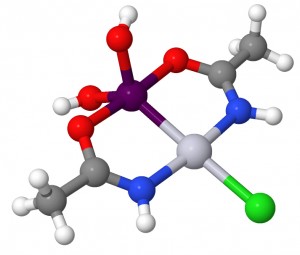Novel Anticancer Drugs
Figure 1. X-ray crystal structure of Arsenoplatin-1. The model is color coded as follows: arsenic (purple), platinum (lt. gray), oxygen (red), nitrogen (blue), chlorine (green), carbon (dark gray) and hydrogen (white). (From Swindell et al., 2013).
Insights into the inorganic chemistry of the cell have led to the development of new therapeutic agents that harness the biological chemistry of metals such as arsenic and platinum. Cisplatin (cis-diamminedichloroplatinum(II)) is commonly used in the treatment of solid tumors in ovarian, testicular, head, neck and bladder cancers. Frequently, however, these cancers become resistant to the drug. Arsenic trioxide is a front line reagent for the treatment of acute promyelocytic leukemia. Both compounds induce apoptotic cell death, but through different biochemical pathways. Together, they work synergistically to improve therapeutic outcomes. The O’Halloran group developed a synthesis method that forms a stable aqueous arsenous acid-platinum complex with biological activity that is distinct from Cisplatin and arsenic trioxide individually. This new compound, Arsenoplatin (Figure 1), is stable in an aqueous environment, can be loaded into a liposome based drug delivery system and most importantly, shows significant biological activity in several cancer cell lines.
Selected publications:
• Miodragovic DU, Quentzel JA, Kurutz JW, Stern CL, Ahn RW, Kandela I, Mazar AP, O’Halloran TV. “Robust Structure and Reactivity of Aqueous Arsenous Acid-Platinum (II) Anticancer Complexes.” Angew. Chem. Int. Ed. Engl., 2013. 52;1-5.
Nanonbin Drug Delivery
Figure 2. Synthesis of Arsenic Nanobins. Lipids are hydrated in a metal (Ni or Cisplatin) acetate solution and sized by high pressure extrusion. The external metal solution is removed and replaced with buffer and arsenic trioxide. Arsenic is loaded into the nanobin by precipitation of arsenic with the metal ions inside the naonobins. (From Swindell et al., 2013).
The group’s work on metal-based anticancer drugs led to the development of nanoscale delivery of multifunctional therapeutic agents for the treatment of hematological cancer and solid tumors. Therapeutic applications for some cancer drugs have been limited by serious systemic toxicities and rapid drug deactivation in vivo. These therapeutic hurdles, however, can be lowered by encapsulating drugs into liposome particles.
To improve the efficacy of these two common anti-cancer therapeutics, the O’Halloran group has developed a method to co-encapsulate high levels of arsenous acids and aqua-cisPt into 100 nm liposomes that are stable in serum but are able to release their drug in the low-pH endosome (Figure 2). These nanobins can also be modified to encapsulate new drugs or to target drugs to cancer cells to avoid systemic toxicity.
Selected publications:
• Sethi, P, Jyoti, A, Swindell, E, Langner, U W, Feddock, J M, Nagarajan, R, O’Halloran T V. and Upreti M. 3D Tumor tissue analogs and their orthotopic implants for understanding tumor-targeting of microenvironment-responsive nanochemotherapy and radiation Nanomedicine: Nanotechnology, Biology & Medicine 2015 Aug 14. pii: S1549-9634(15)00156-2.
• Zhang, Y.; Kenny, H. a; Swindell, E. P.; Mitra, A. K.; Hankins, P. L.; Ahn, R. W.; Gwin, K.; Mazar, A. P.; O’Halloran, T. V; Lengyel, E. Urokinase Plasminogen Activator System-Targeted Delivery of Nanobins as a Novel Ovarian Cancer Therapy. Molecular cancer therapeutics 2013, 12, 2628–39.
• Ahn RW, Barrett SL, Raja MR, Jozefik JK, Spaho L, Chen H, Bally MB, Mazar AP, Avram MJ, Winter JN, Gordon LI, Shea LD, O’Halloran TV, Woodruff TK. Nano-Encapsulation of Arsenic Trioxide Enhances Efficacy Against Murine Lymphoma Model while Minimizing Its Impact on Ovarian Reserve In Vitro and In Vivo. PLoS one. 2013;8(3):e58491.
• Krovi, S.A.; Swindell, E.P.; O’Halloran, T.V.; Nguyen, S.T., “Improved anti-proliferative effect of doxorubicin-containing polymer nanoparticles upon surface modification with cationic groups,” J. Mater. Chem., 2012, DOI: 10.1039/C2JM35420A.
• Lee S-M, Song Y, Hong BJ, Macrenaris KW, Mastarone DJ, O’Halloran TV, Meade TJ, Nguyen ST. Modular polymer-caged nanobins as a theranostic platform with enhanced magnetic resonance relaxivity and pH-responsive drug release. Angew. Chem. Int. Ed. 2010 Nov 16
• Lee S-M, O’Halloran TV, Nguyen ST. Polymer-caged nanobins for synergistic cisplatin-doxorubicin combination chemotherapy. J Am Chem Soc. 2010 Nov 15
• Lee S-M, Ahn RW, Chen F, Fought AJ, O’Halloran TV, Cryns VL, Nguyen ST. Biological evaluation of pH-responsive polymer-caged nanobins for breast cancer therapy. ACS Nano. 2010 Sep 28;4(9):4971-8
• Ahn, R.W., Chen, F., Chen, H., Stern, S.T., Clogston, J.D., Patri, A.K., Raja, M.R., Cryns, V.L., O’Halloran, T.V. “A Novel Nanoparticulate Formulation of Arsenic Trioxide with Enhanced Therapeutic Efficacy in a Murine Model of Breast Cancer” Clin Cancer Res. 2010. Accepted for Publication May 2010.
• Chen, H., Pazicni, S., Krett, N.L., Ahn, R.W., Penner-Hahn, J.E., Rosen, S.T. and O’Halloran, T.V. Coencapsulation of Arsenic- and Platinum based Drugs for Targeted Cancer Treatment.Angew. Chem. Int. Ed. 2009 Nov 5;48(49):9295-9299.
• Lee SM, Chen H, O’Halloran T.V., Nguyen SBT. Clickable’ Polymer-Caged Nanobins as a Modular drug Delivery Platform. J. Amer. Chem. Soc. 2009 131(26):9311-20.
• Chen H, Ahn R, Van den Bossche J, Thompson DH, O’Halloran T.V. Folate-mediated Intracellular Drug Delivery Increases the Anti-cancer Efficacy of Nanoparticulate Formulation of Arsenic Trioxide. Molecular Cancer Therapeutics. 2009 8(7):1955-63.
• Chen, H., MacDonald, R.C., Li, S., Krett, N.L., Rosen, S.T., O’Halloran, T.V. “Lipid encapsulation of arsenic trioxide attenuates cytotoxicity and allows for controlled anticancer drug release.” J. Amer. Chem. Soc., 2006, 128, 13348-13349.


